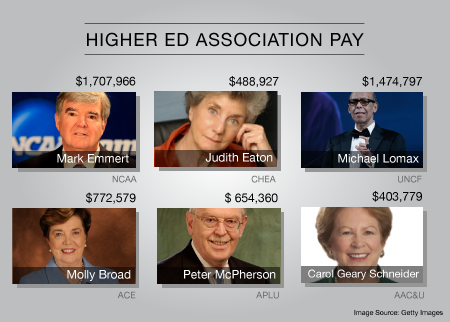You have /5 articles left.
Sign up for a free account or log in.
Salaries for executives at higher education trade associations rival those of top-paid college presidents.
Compensation for the leaders of these higher ed groups – which are considered nonprofits by the IRS – has climbed in recent years.
Twenty-seven of 48 association heads earned about as much or more than the median salary for a university president, which was about $400,000 in 2012-13.
The highest-paid sitting association leader is Mark Emmert of the National Collegiate Athletic Association. He earned $1.7 million from fall 2012 to fall 2013.
The second-highest-paid sitting leader, Michael Lomax, runs the United Negro College Fund. The UNCF, as it is known, supports the nation’s private historically black colleges – many of which are struggling financially – and provides scholarships for students from low-income families. Lomax earned over $1.4 million from spring 2012 to spring 2013, including $101,000 in performance-based incentives and $695,000 in retirement payouts from his previous eight years as UNCF’s leader.
 “The impression, for me at least, is that it looks like the higher education trade industry is a substantial industry, in which executives are well-compensated, in some cases extremely well-compensated,” said James Finkelstein, a public policy professor at George Mason University who studies executive compensation in higher education.
“The impression, for me at least, is that it looks like the higher education trade industry is a substantial industry, in which executives are well-compensated, in some cases extremely well-compensated,” said James Finkelstein, a public policy professor at George Mason University who studies executive compensation in higher education.
Finkelstein said the high salaries raised questions about the public good being carried out by these organizations, all of which are classified as nonprofits
"What purpose are they serving for the greater good?” he said. “I don’t know the answer for that, but that seems to me the question that needs to be asked.”
Inside Higher Ed looked at tax filings for all 48 members of the rarely discussed Washington Higher Education Secretariat. That group includes the American Council on Education, the umbrella lobbying group for the higher ed sector; the Association of American Universities, which represents 62 leading research universities; and the American Association of University Professors. Most of the associations also go collectively by the collective metonym “One Dupont,” after the address many share in a Washington office building.
Because of lag time in IRS reporting requirements and because the associations start and end their budget years at different times, the results are not always directly comparable. Associations were asked for their most recent nonprofit tax filing, known as a 990. Some associations didn’t reply, so their most recent publicly available filings were pulled from Guidestar, a nonprofit that tracks other nonprofits’ finances.
A more recent look by executive compensation firm Quatt Associates, conducted on behalf of the Secretariat members themselves in 2014, found the median compensation of its associations' CEOs was $419,000 per year.
Some of the associations are active in trying to fend off regulatory efforts, including President Obama’s plan for a college rating system and federal efforts to protect students from sexual assault. Others have lobbied for the government to increase aid to students or to institutions. Stills others’ bread and butter is simply selling tests to high school and college students, like the ACT, SAT and GRE.
Senator Chuck Grassley, who has taken a keen interest in higher education salary and benefits, said it’s been clear for a while that tax-exempt organizations tend to use the same few salary-setting firms to get salary recommendations.
“That ramps up compensation for everyone,” Grassley, Republican of Iowa, said in a statement. “While tax-exempt organizations may be subject to a penalty tax if compensation is found to be unreasonable, it is rare for the IRS to challenge pay that is based on a compensation study. The onus is on the public, potential donors and the organization’s board of directors to gauge whether compensation is appropriate."
The higher ed associations, which include trade associations and professional membership organizations, appear to pay their executives in line with other trade and professional organizations.
The smallest of the higher ed associations, those with revenue of less than $5 million, offered median compensation packages of about $260,000 a year, including benefits. The average for trade associations of a similar size in is about $226,000, according to ASAE: the Center for Association Leadership. By contrast, higher ed associations with larger budgets – between $5 million and $25 million – seem to be paying their CEOs tens of thousands less than most other trade associations of a similar size. Other trade associations generally represent for-profit industries, and most professional societies represent employees at companies, whereas higher ed associations almost exclusively represent nonprofit colleges and universities and the people they employ.
Leading the Pack
Three major test-makers -- College Board, ACT and ETS – are members of the Secretariat and each hauls in hundreds of millions of dollars a year in revenue from across the globe. The highest-paid of all Secretariat association leaders, including those no longer in office, was Gaston Caperton, who left the College Board in 2012. But his last year in office was a lucrative one: he made $1.8 million. His base salary was $445,000, but he received $1.1 million in incentive compensation in addition to deferred compensation payouts and other benefits. His salary had drawn scrutiny in the past. In 2011, Bloomberg noted he made more than the president of Harvard University. A full year’s pay for his successor at the College Board, David Coleman, was not yet available, but the board reported paying him $116,000 for his first nine months on the job.
The three test manufacturers and the NCAA all bring in hundreds of millions of dollars in revenue, something many other organizations do not.
The UNCF receives about $200 million a year in revenue. Lomax earned $1,474,000 and also reported $476,000 in prior deferred compensation that is not counted as part of the $1.47 million.
The fund defended the pay package as designed and approved by its board’s compensation committee “based on an analysis of comparable not-for-profit organizations of similar size and complexity.”
“Dr. Lomax’ base salary in 2012 was $353,715 and his performance-based incentive was $101,834, for a total yearly compensation of $455,549,” the statement said. “The remaining amount of his reported compensation, which totals $1.47 million, relates to retirement payouts covering the past eight years ($695,379) and another accrual for future retirement amounts ($295,698). These amounts have been driven by a change in the tax laws issued in 2008 requiring taxes on retirement benefits to be paid in the year the benefit is earned (vested).”
Some leaders drew decent salary and benefits even as their associations spend more money than they generate.
The Council for Opportunity in Education, which advocated on behalf of programs mostly supported by federal dollars for low-income and first-generation students and students with disabilities, spent $845,000 more than it brought in from summer 2012 to summer 2013. The organization’s net assets were actually negative $3.1 million during that period. At the same time, now-retired President Arnold Mitchem earned $528,000 in his last year at the council.
The council’s current president, Maureen Hoyler, said the council had switched auditors and the new auditors used an accounting method that created the revenue shortfall on paper. She acknowledged the overall net assets were negative. She said the organization is trying to increase its assets, though, which were negative going back at least another year.
“We’re actively trying to increase our asset base, that’s something that my board and I are very serious about and are taking active steps to do,” Hoyler said in a telephone interview.
She defended Mitchem’s compensation package: Mitchem founded the council and worked there for over three decades. Fifty thousand dollars of his final year’s compensation had been retirement-related.
Walter Bumphus, president of the American Association of Community Colleges, earned $568,000 in 2012 – twice the median salary of the presidents of the nation's community colleges – even as revenue at the association declined. The association took in $2.6 million less than it had the year before, even as it spent $370,000 more.
“In any given year the grant revenue may increase or decrease due to new projects taken on by the Association or projects closing during a given year,” Ramsay Johnson, the association’s chief financial officer said in an email.
Some of the associations pay a significant chunk of all the money they bring in – usually from membership dues – to their top executive.
Steven A. Wartman, a medical doctor who leads the Association of Academic Health Centers, took home $731,000, which was 21.2 percent of his association’s total revenue in the 2012 tax year.
David Warren, the longtime leader of the National Association of Independent Colleges and Universities, earned $929,000. That represented 16 percent of the association’s revenue that year. Warren, who represents about 1,000 private colleges, made more than all but about 50 of the nation’s private college presidents. The total included $300,000 in deferred compensation from a two-year contract that ran from 2010-2012. (Note: This paragraph has been updated to clarify details of Warren's compensation.)
Tracy Fitzsimmons, the chair of NAICU’s board and president of Shenandoah University, in Virginia, said that under Warren’s leadership the group had “proudly been the most activist of the six presidential associations” that represent higher ed. She said being president of NAICU and president of a college are “markedly different functions.”
“His initiatives include leading ‘Stop the Raid on Student Aid’ and turning back SPRE [state-designated postsecondary review entities] in the 1990s, defeating Congressional attempts to impose price controls earlier in this century, and fighting current efforts to measure institutional quality through inappropriate metrics,” Fitzsimmons said in an email. “With regard to support for student aid, Dr. Warren played an instrumental role in passing tax provisions that helped families and students save for college, pay for college and repay student loans, and strongly supported historic increases in the Pell Grant, and maintenance of the campus-based aid programs.”
The lowest-paid association president was the Rev. Gregory Lucey, the head of the Association of Jesuit Colleges and Universities, who has since moved on from the post. Father Lucey, who as a Jesuit took a vow of poverty, was paid nothing, though the association gave him allowances of $37,000 for living and other personal expenses. The second-lowest-paid is Lezlie Baskerville, president of the National Association for Equal Opportunity in Higher Education, who made $190,000 from summer 2011 to summer 2012, the most recent period for which filings are available.
Other association leaders who made less than Warren also took home about 16 percent of their association’s total revenue, including Judith Eaton of the Council for Higher Education Accreditation, who earned $488,000, and Anthony DeCrappeo of the Council on Governmental Relations, who earned $348,000.
Finkelstein said the high share of revenue going straight into executives’ pockets could raise eyebrows.
“One conclusion – I’m not saying it’s my conclusion – is that this organization is there to generate funds to pay the executive salary,” he said.
Below is a table of total compensation for executives at higher ed trade associations. Total compensation includes base compensation, bonus and incentive pay, deferred compensation, benefits and other compensation.
| Organization | Chief Executive | Total Compensation |
| ACT, Inc. Workforce Development Division | Jon S. Whitmore | $789,086 |
| American Association of Colleges for Teacher Education | Sharon P. Robinson | $348,071 |
| American Association of Colleges of Nursing | Geraldine D. Bednash (retired summer 2014) | $388,551 |
| American Association of Collegiate Registrars and Admissions Officers | Jerome Sullivan (Retired) | $431,389 |
| American Association of Community Colleges | Walter Bumphus | $568,978 |
| American Association of State Colleges and Universities | Muriel Howard | $551,420 |
| American Association of University Professors | Martin Snyder (retired December 2013) | $196,043 |
| American College Personnel Association | Gregory Roberts (took another title in summer 2014) | $228,027 |
| American Council on Education | Molly Broad | $772,579 |
| American Dental Education Association | Richard Valachovic | $543,132 |
| American Indian Higher Education Consortium | Carrie Billy | $287,193 |
| Association of Academic Health Centers | Steven A. Wartman | $731,601 |
| Association of American Colleges and Universities | Carol Geary Schneider | $403,779 |
| Association of American Law Schools | Susan Westerberg Prager (Left in 2013) | $465,242 |
| Association of American Medical Colleges | Darrell Kirch | $1,281,097 |
| Association of American Universities | Hunter Rawlings | $615,155 |
| Association of Catholic Colleges and Universities | Michael Galligan-Stierle | $260,390 |
| Association of Community College Trustees | J. Noah Brown | $349,999 |
| Association of Governing Boards of Universities and Colleges | Richard Legon | $554,860 |
| Association of Higher Education Facilities Officers | E. Lander Medlin | $276,143 |
| Association of Jesuit Colleges and Universities | Gregory Lucey (left in spring 2013) | $ 0 |
| Association of Public and Land-grant Universities | Peter McPherson | $654,360 |
| Association of Research Libraries | Charles Lowry (left in December 2012) | $393,814 |
| College and University Professional Association for Human Resources | Andy Brantley | $321,733 |
| Council for Advancement and Support of Education | John Lippincott | $552,516 |
| Council for Christian Colleges and Universities | Paul Courts (stepped down at end of 2012) | $273,002 |
| Council for Higher Education Accreditation | Judith Eaton | $488,927 |
| Council for Opportunity in Education | Arnold Mitchem (Ret.) | $528,578 |
| Council of Graduate Schools | Debra Stewart (Stepped down June 2014) | $554,888 |
| Council of Independent Colleges | Richard Ekman | $685,389 |
| EDUCAUSE | Diana Oblinger | $472,835 |
| ETS | Kurt M. Landgraf | $1,322,779 |
| Hispanic Association of Colleges and Universities | Antonio R. Flores | $500,977 |
| NAFSA: Association of International Educators | Marlene M. Johnson | $339,729 |
| NASPA-Student Affairs Administrators in Higher Education | Kevin Kruger | $292,603 |
| National Association for College Admission Counseling | Joyce Smith | $303,987 |
| National Association for Equal Opportunity in Higher Education | Lezlie Baskerville | $190,500 |
| National Association of College and University Attorneys | Kathleen Curry Santora | $353,150 |
| National Association of College and University Business Officers | John Walda | $563,506 |
| National Association of Independent Colleges and Universities | David Warren | $929,852 |
| National Association of Student Financial Aid Administrators | Justin Draeger | $273,102 |
| National Collegiate Athletic Association | Mark Emmert | $1,707,966 |
| National Council of University Research Administrators | Kathleen Larmett | $215,654 |
| The College Board | Gaston Caperton (Retired) | $1,848,009 |
| The Council on Governmental Relations | Anthony DeCrappeo | $348,009 |
| Thurgood Marshall College Fund | Johnny C. Taylor Jr. | $526,663 |
| United Negro College Fund, Inc. | Michael Lomax | $1,474,797 |
| University Professional & Continuing Education Association | Robert Hansen (Compensation figure only for six months) | $108,875 |
Figures for most associations are from publicly available tax filings for the 2012 tax year, which ended for most associations in summer 2013. Five are from the 2013 tax year, which ran from Jan. 1 to Dec. 31, 2013 for those five institutions: the Council of Graduate Schools, the Hispanic Association of Colleges and Universities, Educause, the American Association of Colleges for Teacher Education, and NAFSA: Association of International Educators. Two associations' data come from the 2011 tax year: the National Association for Equal Opportunity in Higher Education and the University Professional & Continuing Education Association, which filed a return that covers only the first six months of 2012.








